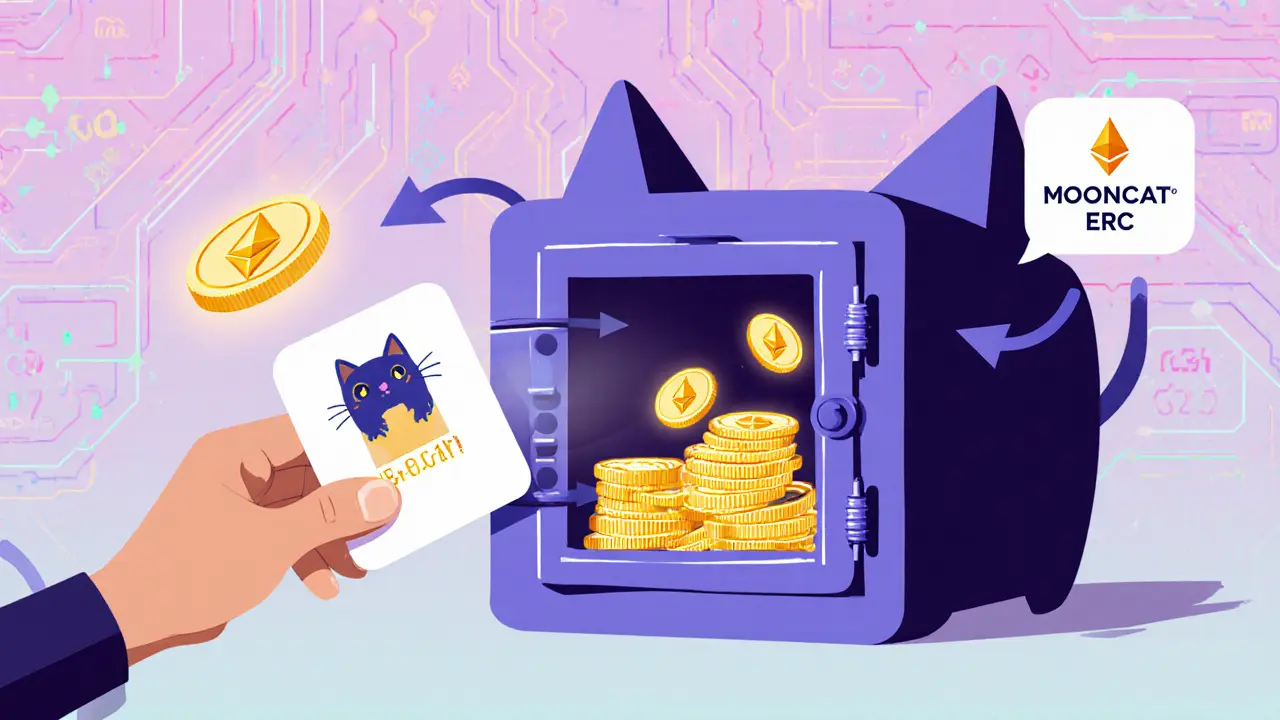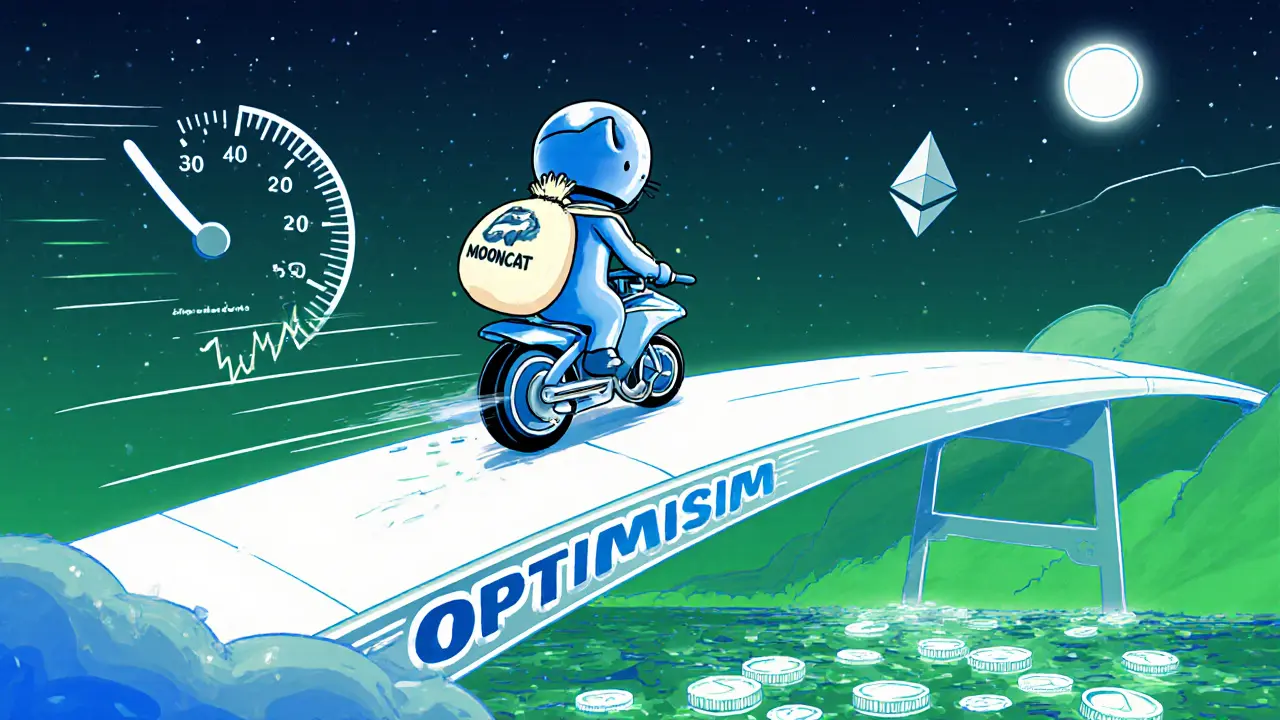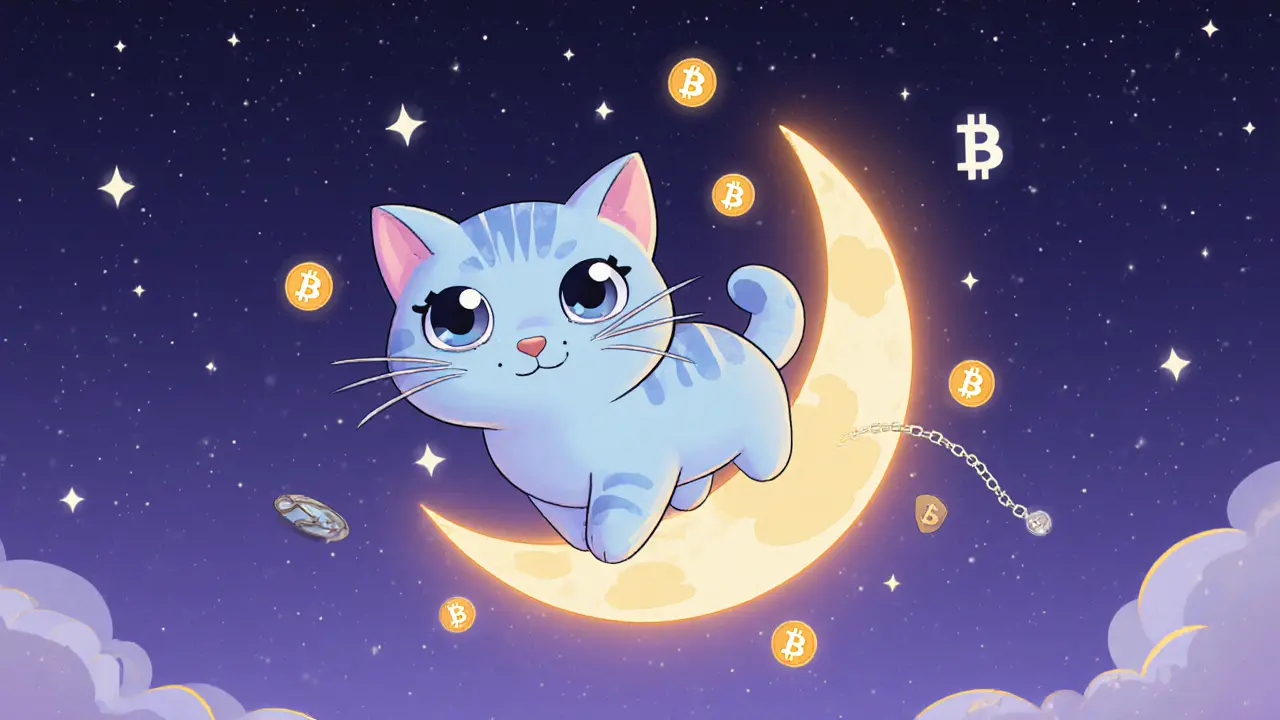Mooncat Token Comparison Tool
Current Value
Key Comparison Metrics
When you hear the term Mooncat crypto coin, you might picture a cute cartoon feline floating over the moon. In reality, the name hides a fairly sophisticated piece of DeFi that blends on‑chain art with tokenized liquidity. This guide breaks down exactly what Mooncat (MOONCAT) is, how the Ethereum‑based ERC‑20 token differs from its Solana counterpart, and whether it’s worth a spot in your portfolio.
Key Takeaways
- Mooncat (MOONCAT) is an ERC‑20 vault token that represents fractional ownership of MoonCats NFTs on Ethereum.
- A separate Solana‑based Mooncat token exists but offers no real utility beyond speculation.
- The token relies on the NFTX protocol to create liquidity for a historically significant on‑chain NFT collection.
- Fees are low (0.5% vault fee) but gas costs on Ethereum can be a barrier.
- Future road‑maps include an Optimism bridge to cut fees and broaden DeFi integration.
Mooncat (MOONCAT) - The Core Concept
Mooncat (MOONCAT) is an ERC‑20 token that serves as a liquid representation of MoonCats NFTs held in an NFTX vault. In simple terms, you deposit a MoonCats NFT, the vault mints MOONCAT tokens for you, and you can trade those tokens on DEXs just like any other crypto. When you want the original NFT back, you burn the tokens and withdraw the cat.
The MoonCats NFT Collection - Why It Matters
MoonCats NFTs are a generative on‑chain collection launched in May 2017, built by the team behind the Ethereum Name Service (ENS). Each cat’s visual DNA is stored directly in the contract, meaning the image can be rendered without any external server. This pure on‑chain approach makes MoonCats one of the earliest examples of truly decentralized NFTs, and it’s the reason the MOONCAT token can claim genuine asset backing.
How the Vault Works - The NFTX Connection
NFTX is a protocol that creates ERC‑20 vault tokens for any ERC‑721 collection. When the MoonCats vault was launched in July 2021, it introduced a smart contract that holds the NFTs and issues MOONCAT tokens at a 1:1 ratio (adjusted for fees). The vault’s fee structure is 0.5% on mint and burn, which is lower than many competitors such as NFT20 (1‑2%).
The vault also includes an emergency withdrawal function, so if the platform ever shuts down users can still retrieve their NFTs, albeit with a small gas cost.

Ethereum vs. Solana Mooncat Tokens - A Side‑by‑Side Comparison
| Feature | Ethereum MOONCAT | Solana Mooncat |
|---|---|---|
| Standard | ERC‑20 | SPL Token |
| Backing | MoonCats NFTs via NFTX vault | No concrete backing, meme‑coin label |
| Launch Year | 2021 (vault) | 2022 |
| Current Price (Oct 2025) | $0.0023 | $0.0011 |
| Market Cap | $2.3 M | $1.1 M |
| Average Daily Tx | 1,300 (incl. gas fees) | ≈2,500 (sub‑second finality) |
| Typical Fee | 0.005‑0.01 ETH per tx | $0.00025 per tx |
| Community Size | ~12,500 Discord members | ~1,200 Discord members |
| Utility | Liquidity for MoonCats NFTs | Speculative trading only |
The Ethereum version offers real asset backing and the ability to earn fractional ownership of a historically important NFT collection. The Solana version, while cheaper to trade, provides no tangible utility and resembles a typical meme coin.
Technical Specs - What’s Under the Hood?
Both tokens follow their chain’s native token standard: ERC‑20 on Ethereum and SPL on Solana. The Ethereum MOONCAT token has 18 decimals, enabling precise fractional trades. Its smart contract includes mint, burn, and a 0.5% vault fee that is automatically deducted from each operation. The underlying MoonCats NFTs are ERC‑721 tokens with fully on‑chain image generation, meaning the token ID and a 256‑bit DNA string contain everything needed to render the cat.
On Solana, the contract address is FNP2Dw2GU5wPBZgVCcerbEemV9dVfvQrThEor1jmoon. The token’s on‑chain code is minimal, offering only balance tracking and transfer functions-no vault, no NFT linkage.
How to Use MOONCAT - Step‑by‑Step
- Install a Web3 wallet (MetaMask for Ethereum, Phantom for Solana).
- Buy a small amount of ETH or SOL to cover gas/transaction fees.
- Visit the NFTX portal, connect your wallet, and locate the MoonCats vault.
- Deposit any MoonCats NFT you own. The vault will mint an equivalent amount of MOONCAT tokens to your address.
- Trade the MOONCAT tokens on supported DEXs (Uniswap, SushiSwap) or hold for potential price appreciation.
- If you want the original NFT back, simply burn the same amount of MOONCAT tokens in the NFTX UI and withdraw the cat.
This flow assumes a basic comfort level with DeFi interfaces. For newcomers, the learning curve is moderate; NFTX’s own documentation estimates 8-10 hours to master vault mechanics.
Pros and Cons - A Balanced View
| Pros | Cons |
|---|---|
|
|

Risk Factors & Regulatory Landscape
Regulators are paying closer attention to tokens that represent ownership of other assets. The SEC’s 2023 framework suggests that ERC‑20 tokens tied to NFTs could be deemed securities if they meet the Howey test. This adds a layer of legal risk for investors, especially if the project were to launch a formal token offering.
Technical risk includes Ethereum network congestion, which can push transaction fees high during peak periods. The upcoming Optimism bridge (see Roadmap Update) aims to mitigate this by moving vault interactions to a Layer 2 solution.
For the Solana version, the primary risk is market perception-most analysts label it a meme coin with a high probability of becoming worthless within 18 months.
Future Outlook - Where Is Mooncat Headed?
The NFTX team announced an Optimism integration slated for Q1 2024. By moving mint and burn operations to Optimism, users could see gas fees drop from ~0.01 ETH to under $0.10 per transaction, dramatically improving accessibility for smaller holders.
Beyond fee reductions, there’s talk of adding “lootprint” NFTs as collateral for lending protocols, potentially turning MOONCAT into a gateway for decentralized borrowing against MoonCats assets.
However, broader market trends matter. NFT‑backed tokens currently hold just 3.2 % of total crypto market cap, and the overall NFT market has contracted since 2022. If demand for NFT fractionalization stalls, MOONCAT’s growth may plateau.
Getting Started - Quick Checklist
- Wallet: MetaMask (Ethereum) or Phantom (Solana).
- Funds: Minimum 0.01 ETH or 0.02 SOL for gas.
- Source of MoonCats NFT: OpenSea, LooksRare, or direct mint from MoonCatRescue.
- Visit NFTX.io, locate the MoonCats vault, and follow the deposit‑mint‑trade flow.
- Keep an eye on the Optimism bridge rollout for lower fees.
Frequently Asked Questions
What does MOONCAT actually represent?
MOONCAT is an ERC‑20 vault token that gives you fractional ownership of MoonCats NFTs stored in an NFTX vault. Each token is backed 1‑to‑1 by the underlying NFT, minus a small fee.
Can I earn yield on MOONCAT?
Yield isn’t built into MOONCAT itself, but you can provide liquidity on DEX pools (e.g., Uniswap) and earn trading fees. The vault also distributes a tiny portion of its fees to token holders.
Is the Solana Mooncat token the same as the Ethereum one?
No. The Solana token shares the name but has no NFT backing or vault mechanism. It’s essentially a speculative SPL token, whereas the Ethereum MOONCAT is asset‑backed via NFTX.
How do I withdraw my original MoonCats NFT?
Burn the same amount of MOONCAT tokens in the NFTX interface, then click the “Withdraw” button. The NFT will be sent back to your wallet after the transaction confirms.
What are the main risks of holding MOONCAT?
Key risks include Ethereum gas spikes, the narrow market for MoonCats NFTs, potential regulatory classification as a security, and the inherent volatility of any crypto asset.
Whether you’re a MoonCats collector looking for liquidity or a DeFi explorer curious about NFT‑backed tokens, understanding the mechanics behind MOONCAT helps you make an informed decision. Keep an eye on the Optimism bridge, watch the NFTX fee structure, and never invest more than you’re prepared to lose.

6 Comments
Melodye Drake
Ugh, I just can't believe people are still getting excited about this. MoonCats are a beautiful piece of crypto history, but turning them into an ERC-20 token feels like putting a plastic crown on the Mona Lisa. The NFTX vault is elegant, sure, but it's still just a liquidity hack for a collection that should be revered, not traded like Dogecoin. And don't even get me started on the Solana version-like, wow, you really want to trade a meme with zero provenance? Please. I keep my MoonCats locked in cold storage, and I'm not letting some DeFi bot touch them. This isn't finance-it's digital archaeology.
Also, gas fees? Please. If you can't afford to pay 0.01 ETH to interact with a piece of blockchain art that predates CryptoKitties, maybe you shouldn't be in this space at all. The real luxury is owning something that exists purely on-chain. Everything else is just noise.
Also, why are we even talking about Solana? It's a glorified spreadsheet with a blockchain sticker on it.
paul boland
Oh for crying out loud-another American trying to sell us Ethereum as the only real blockchain?! 😤
Irish people have been trading digital collectibles since before Ethereum was a glimmer in Vitalik’s eye! Solana’s transaction speed is 1000x faster, fees are literally pennies, and guess what? People are actually USING it. You think your 0.01 ETH gas fee is ‘luxury’? That’s a coffee in Dublin, mate. Here, we call it ‘taxation without representation’!
And MoonCats on Solana? Fine. Let the Americans cling to their slow, expensive nostalgia. We’ll be over here buying, selling, and minting with zero drama. The future isn’t on L1s that take 15 seconds to confirm a trade. It’s on chains that work. 🇮🇪⚡️
Also, your ‘historical significance’ argument is just FOMO in a tuxedo. Get over it.
harrison houghton
There is a deeper truth here. Not about tokens. Not about chains. But about ownership. What does it mean to own something digital? The MoonCats were born from pure code-no server, no central authority, no middleman. That is the soul of the internet. The ERC-20 token is not a betrayal-it is an evolution. A way to share the sacred with those who cannot hold the original. To own a fraction of a MoonCat is to own a piece of the first digital cathedral.
But Solana? Solana is the mall. It has neon lights and cheap souvenirs. It has no soul. It has no history. It has no DNA encoded in the contract. It has a token address. That is not art. That is advertising.
And yes, gas fees hurt. But pain is the price of authenticity. You want cheap? Go buy a JPEG from a Shopify store. But if you want to touch the soul of crypto? You kneel. You pay. You wait. And then you hold.
This is not finance. This is ritual.
DINESH YADAV
Why are Americans always acting like they invented blockchain? MoonCats? Cute. But India has been building real decentralized systems for years. We don't need your NFTX vaults or your Ethereum gas fees. We build on public chains that serve real people. Solana is fast, cheap, and open. Your ‘historical’ NFTs are just JPEGs with a fancy label. Meanwhile, Indian developers are building DeFi for farmers and small businesses. You're playing with digital cats while we're building digital infrastructure.
Stop romanticizing your own elitism. The future is in speed, scale, and accessibility-not in paying $50 in gas to trade a cartoon cat that costs less than your morning chai.
rachel terry
Gas fees are the real problem here. Why are we still on Ethereum when everything else moved on? The vault is clever but it's a Band-Aid on a broken leg. And calling MoonCats ‘historically significant’ is like calling a flip phone a collector’s item because it had a built-in snake game.
Also the Solana version has higher volume so clearly the market is speaking. You think you're preserving art? You're just hoarding. The whole point of liquidity is to let things breathe. Your emotional attachment to a 2017 pixel cat is cute but it's not economics.
Also why is everyone so mad about Solana? It's not a crime to want fast transactions. Chill out. It's just crypto.
Also also the 0.5% fee is fine but where's the yield? Where's the staking? Where's the governance? If this is supposed to be DeFi why is it just a static vault? This feels like a museum exhibit with a price tag.
Susan Bari
Stop. Just stop.
This isn't about tokens or chains or fees.
This is about the fact that someone, in 2017, wrote a program that could generate a unique cat from pure randomness on the blockchain-with no images, no servers, no central point of failure.
That is magic.
Everything after that-the vaults, the tokens, the memes, the Solana clones-is just noise.
They didn't make a currency.
They made a living artifact.
And you're all arguing over the price of a key to a cathedral you've never stepped inside.
Go touch the code.
Then come back and tell me what you saw.